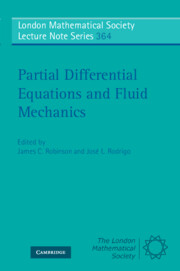Book contents
- Frontmatter
- Contents
- Preface
- List of contributors
- 1 Shear flows and their attractors
- 2 Mathematical results concerning unsteady flows of chemically reacting incompressible fluids
- 3 The uniqueness of Lagrangian trajectories in Navier–Stokes flows
- 4 Some controllability results in fluid mechanics
- 5 Singularity formation and separation phenomena in boundary layer theory
- 6 Partial regularity results for solutions of the Navier–Stokes system
- 7 Anisotropic Navier–Stokes equations in a bounded cylindrical domain
- 8 The regularity problem for the three-dimensional Navier–Stokes equations
- 9 Contour dynamics for the surface quasi-geostrophic equation
- 10 Theory and applications of statistical solutions of the Navier–Stokes equations
8 - The regularity problem for the three-dimensional Navier–Stokes equations
Published online by Cambridge University Press: 07 September 2011
- Frontmatter
- Contents
- Preface
- List of contributors
- 1 Shear flows and their attractors
- 2 Mathematical results concerning unsteady flows of chemically reacting incompressible fluids
- 3 The uniqueness of Lagrangian trajectories in Navier–Stokes flows
- 4 Some controllability results in fluid mechanics
- 5 Singularity formation and separation phenomena in boundary layer theory
- 6 Partial regularity results for solutions of the Navier–Stokes system
- 7 Anisotropic Navier–Stokes equations in a bounded cylindrical domain
- 8 The regularity problem for the three-dimensional Navier–Stokes equations
- 9 Contour dynamics for the surface quasi-geostrophic equation
- 10 Theory and applications of statistical solutions of the Navier–Stokes equations
Summary
Abstract
This paper gives a brief summary of some of the main results concerning the regularity of solutions of the three-dimensional Navier–Stokes equations. We then outline the basis of a numerical algorithm that, at least in theory, can verify regularity for all initial conditions in any bounded subset of H1.
Introduction
The aim of this paper is to present some partial results concerning the problem of regularity of global solutions of the three-dimensional Navier–Stokes equations. Since these equations form the fundamental model of hydrodynamics it is a matter of great importance whether or not they can be uniquely solved. However, one hundred and fifty years after the Navier–Stokes model was presented for the first time, we still lack an existence and uniqueness theorem, and the most significant contributions to the subject remain those of Leray (1934) and Hopf (1951).
Nevertheless, there have been many advances since their work, and it would not be possible to give an exhaustive presentation of these in a short article. We give a brief overview of some of the main results, and then concentrate on one specific and in some ways non-standard approach to the problem, with a discussion of the feasibility of testing for regularity via numerical computations following Chernysehnko et al. (2007), Dashti & Robinson (2008), and Robinson & Sadowski (2008). In some ways this contribution can be viewed as a companion to the introductory review by Robinson (2006).
- Type
- Chapter
- Information
- Partial Differential Equations and Fluid Mechanics , pp. 185 - 206Publisher: Cambridge University PressPrint publication year: 2009

